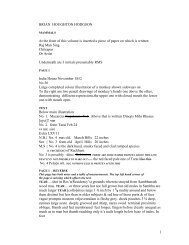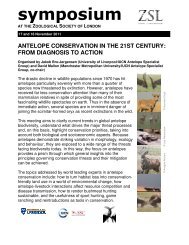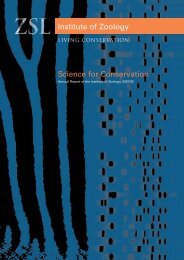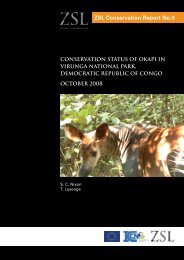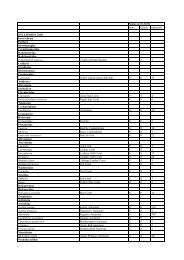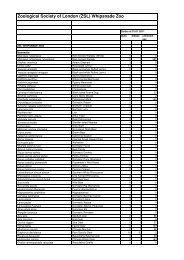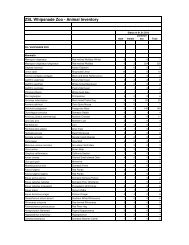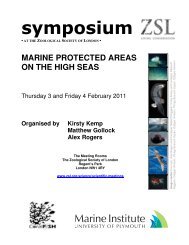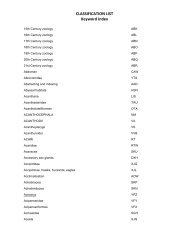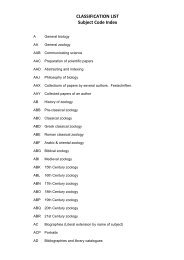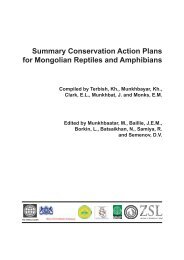the status and distribution of the greater one-horned rhino in nepal
the status and distribution of the greater one-horned rhino in nepal
the status and distribution of the greater one-horned rhino in nepal
Create successful ePaper yourself
Turn your PDF publications into a flip-book with our unique Google optimized e-Paper software.
Habitat : A habitat is a space (which <strong>in</strong>cludes food, water <strong>and</strong> shelter) suitable for <strong>the</strong> survival <strong>and</strong><br />
reproducti on <strong>of</strong> an organism or <strong>the</strong> local environment <strong>in</strong> which a specifi ed organism, populati on,<br />
or species lives, characterized by physical <strong>and</strong> chemical features, <strong>and</strong> <strong>the</strong> presence <strong>of</strong> certa<strong>in</strong> o<strong>the</strong>r<br />
species.<br />
Home Range : The area <strong>in</strong> which an animal usually resides <strong>and</strong> moves <strong>in</strong> search <strong>of</strong> water, food <strong>and</strong><br />
shelter. Home range is diff erent from territory – <strong>the</strong> latt er be<strong>in</strong>g an area acti vely defended (usually by<br />
a dom<strong>in</strong>ant male).<br />
Intensive Protecti on Z<strong>one</strong> (IPZ) : A defi ned z<strong>one</strong> with<strong>in</strong> a larger protected area where law enforcement<br />
staff are deployed at moderate to high density specifi cally for protecti ng <strong>rh<strong>in</strong>o</strong>. The concentrati on <strong>of</strong><br />
<strong>rh<strong>in</strong>o</strong>s with<strong>in</strong> an IPZ refl ects natural patt erns <strong>of</strong> distributi on <strong>and</strong> movement, <strong>and</strong> is not <strong>the</strong> deliberate<br />
result <strong>of</strong> fenc<strong>in</strong>g <strong>and</strong> o<strong>the</strong>r methods <strong>of</strong> confi nement.<br />
Invasive Alien Plant Species : Introduced plant species that are rapidly exp<strong>and</strong><strong>in</strong>g outside <strong>of</strong> <strong>the</strong>ir nati ve<br />
range. Invasive species can alter ecological relati onships among nati ve species <strong>and</strong> can aff ect ecosystem<br />
functi on <strong>and</strong> human health. A plant species is regarded as <strong>in</strong>vasive if it: (1) has been <strong>in</strong>troduced by<br />
human, birds etc. to a locati on where it did not previously occur naturally <strong>and</strong> (2) spreads widely<br />
throughout <strong>the</strong> new locati on. Certa<strong>in</strong> <strong>in</strong>vasive species can smo<strong>the</strong>r <strong>and</strong> replace <strong>in</strong>digenous species<br />
<strong>and</strong> can signifi cantly lower carry<strong>in</strong>g capaciti es for <strong>rh<strong>in</strong>o</strong>s <strong>and</strong> o<strong>the</strong>r species impacti ng negati vely on<br />
conservati on <strong>of</strong> biodiversity.<br />
In-situ : The natural habitat <strong>of</strong> a species. Wild <strong>rh<strong>in</strong>o</strong> be<strong>in</strong>g conserved <strong>in</strong> natural habitat with<strong>in</strong> <strong>the</strong><br />
historic range <strong>of</strong> <strong>the</strong> species.<br />
Metapopulati on : A number <strong>of</strong> sub-populati ons <strong>of</strong> a species managed collecti vely as <strong>one</strong> s<strong>in</strong>gle<br />
populati on with occasional movement <strong>of</strong> animals from <strong>one</strong> sub-populati on to ano<strong>the</strong>r.<br />
Notch<strong>in</strong>g : A method <strong>of</strong> surgically cutti ng ‘V’ shaped notches from specifi c positi ons on a <strong>rh<strong>in</strong>o</strong>’s ear<br />
which enables <strong>the</strong> animal to be coded numerically <strong>and</strong> easily identi fi ed (<strong>and</strong> monitored) <strong>in</strong> <strong>the</strong> wild.<br />
Sanctuary : A small part <strong>of</strong> a protected area <strong>in</strong> which <strong>rh<strong>in</strong>o</strong> are deliberately confi ned through perimeter<br />
fenc<strong>in</strong>g, <strong>the</strong> use <strong>of</strong> natural barriers or o<strong>the</strong>r methods <strong>of</strong> confi nement <strong>and</strong> where law enforcement<br />
staff are deployed at high density to protect <strong>the</strong> <strong>rh<strong>in</strong>o</strong> populati on. The confi nement <strong>of</strong> <strong>rh<strong>in</strong>o</strong> with<strong>in</strong> a<br />
sanctuary permits close observati on <strong>and</strong> relati vely <strong>in</strong>tense management <strong>and</strong> protecti on <strong>of</strong> <strong>the</strong> <strong>rh<strong>in</strong>o</strong>.<br />
Social Carry<strong>in</strong>g Capacity : Maximum number <strong>of</strong> a <strong>rh<strong>in</strong>o</strong>s that can be supported <strong>in</strong> a given area without<br />
<strong>the</strong> behavioural characteristi c <strong>of</strong> <strong>rh<strong>in</strong>o</strong>s compromis<strong>in</strong>g <strong>the</strong>ir reproducti ve performance. In practi cal<br />
terms <strong>the</strong> primary concern is <strong>the</strong> social carry<strong>in</strong>g capacity <strong>of</strong> adult males.<br />
Species : A taxonomic group whose members can <strong>in</strong>terbreed <strong>and</strong> produce viable ferti le <strong>of</strong>f spr<strong>in</strong>g; also<br />
based on geneti c <strong>and</strong> morphological diff erences between species.<br />
Translocati on : Movement <strong>of</strong> <strong>in</strong>dividual <strong>rh<strong>in</strong>o</strong>s from <strong>one</strong> area to ano<strong>the</strong>r, ei<strong>the</strong>r to improve chances <strong>of</strong><br />
survival, to establish new populati ons, to keep established populati ons producti ve or to <strong>in</strong>troduce new<br />
blood <strong>in</strong>to a populati on. Rh<strong>in</strong>os may be translocated to o<strong>the</strong>r areas <strong>of</strong> suitable habitat <strong>and</strong> to where <strong>the</strong>y<br />
may be bett er protected from poachers. Translocati on is a necessary comp<strong>one</strong>nt <strong>of</strong> metapopulati on<br />
management.<br />
IX



